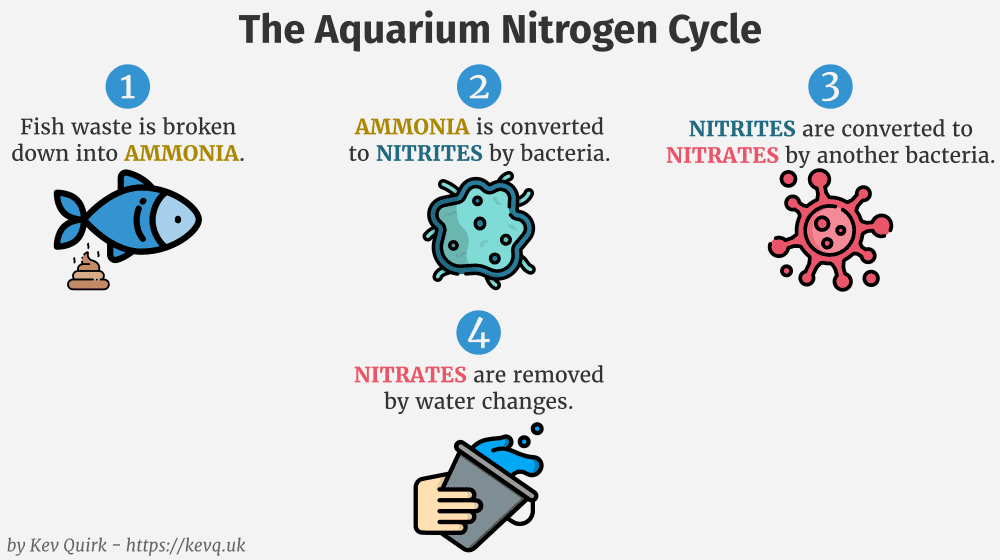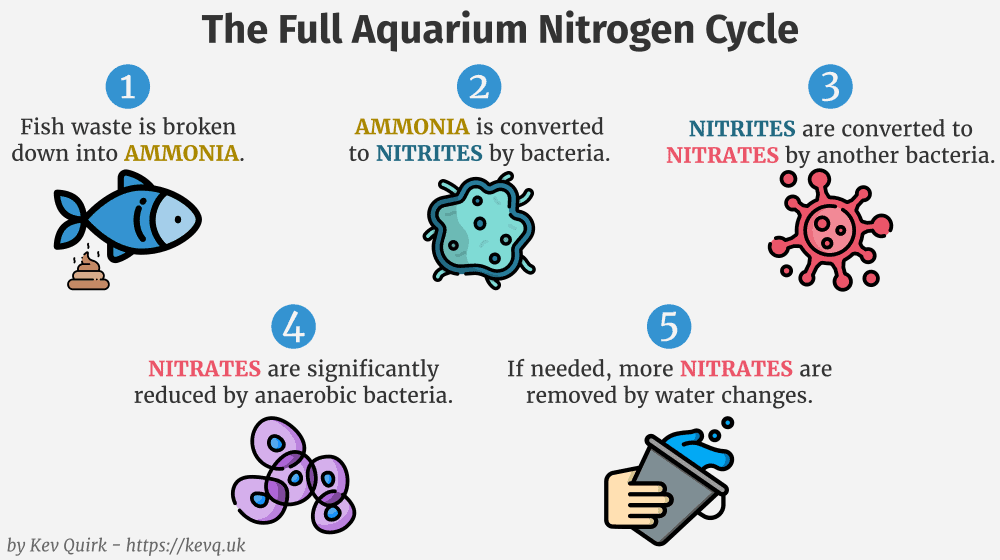How The Aquarium Nitrogen Cycle Works
16 Mar 2020
The nitrogen cycle is one of the first things most fishkeepers learn, but many don’t achieve (or don’t know about) the FULL nitrogen cycle. This post may help you have better water quality, so you have to do fewer water changes. But most importantly, your fish will be happier and healthier.
So we all know the nitrogen cycle, right? Fish poo > ammonia > nitrite > nitrate. If you don’t know what the nitrogen cycle is, I’ll start by explaining that first.
The Traditional Nitrogen Cycle
So if you’re not aware, the traditional nitrogen cycles involves 4 main stages:
- Your fish produce waste which is broken down into ammonia.
- Ammonia is extremely toxic to fish, so any ammonia in your aquarium is really bad.
- Once ammonia is present in your aquarium, a culture of bacteria develops that feeds on the ammonia and turns it into nitrites.
- Nitrites are also toxic to your fish. So again, any signs of nitrites in your water is really bad.
- Now you have all of your ammonia turned into nitrites, another bacteria starts to form which turns nitrites into nitrates.
- While not as bad for your fish as ammonia or nitrites, nitrates are still bad for your fish in high quantities.
- Nitrates are removed from the water column by doing water changes.
Here’s the whole thing in a nice, easy to digest diagram:

Different people have a different gauge as to what the limit for nitrates should be. Personally, I start to get concerned if my nitrates exceed 40ppm. I'd be really concerned if they hit 80ppm. Always aim for the lowest possible number of nitrates.
All good in the hood, right? You do your regular water tests and you have no ammonia or nitrite, and a steady supply of nitrate building up. Done. Finitio. Let’s all go home…right?
Not quite.
That is not the complete nitrogen cycle. What if I told you that you could add another step so that your nitrates also reduce as part of the cycle? Well, they can folks!
Anaerobic Bacteria
This is where anaerobic bacteria comes into the mix. They will feed on your nitrates, reducing their numbers to much safer levels. This means better water parameters, fewer water changes and, most importantly, happier fish.
Again, for your viewing pleasure, here’s the FULL cycle in an easy to consume diagram:

So Kev, why isn’t everyone doing this?
That’s a great question, fair reader. You see, a lot of people find it difficult to create a colony of anaerobic bacteria, because they require very specific conditions in which to grow. Whereas the bacteria in stages 2 and 3 will grow pretty much anywhere there is water and waste.
Anaerobic organisms do not require oxygen to survive. In fact, the presence of oxygen can kill them. So in order to create a colony of anaerobic bacteria, you need a place that is full of water, nitrate and void of oxygen.
That’s pretty difficult considering your fish and stage 2 & 3 bacteria need oxygen to survive. See why this is hard to achieve now? 🙂
It’s all about the media
Getting a full cycle is all about getting the right biological media in your filtration system. I’m not going to go into specifics in this post - I’ll save that for another day. But you need a media that not only has a large surface area for the aerobic bacteria to thrive, but also lots of nooks and crannies for the anaerobic colony to take hold too.
Aerobic bateria only takes a couple of weeks to establish a colony, whereas anaerobic bateria can take months to establish. So don’t expect this to occur overnight. But, given the right conditions, it will happen.
Once you have this, you will notice that your nitrates start to significantly reduce. Like I said, I will do a separate post on what media to use, and how to setup filtration correctly.
In the meantime, you can sleep well tonight knowing that you now know a little more about the nitrogen cycle, and there is a way to reduce those pesky nitrates without doing water changes every week.